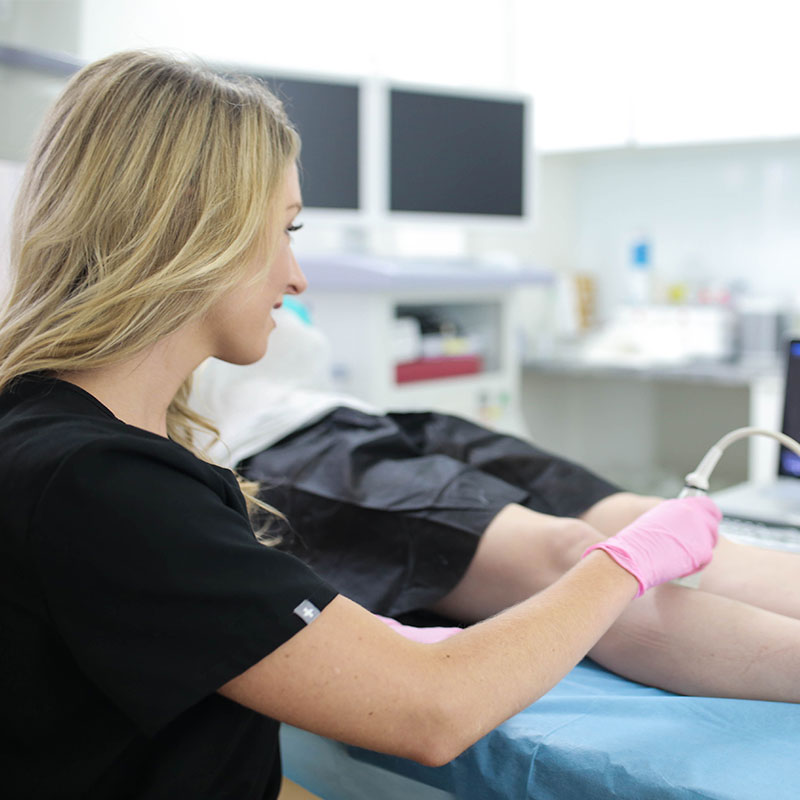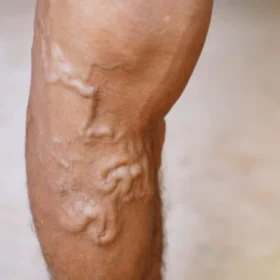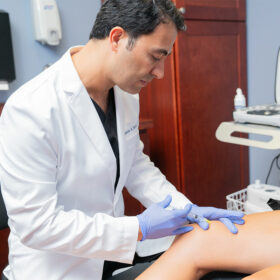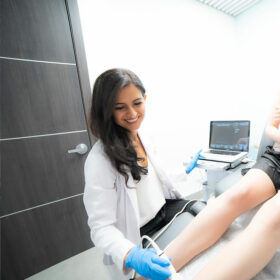If you’re dealing with varicose veins, you’re probably eager to find relief. One of the common questions we hear at Vein Treatment Clinic is, “How long does varicose vein treatment take?” The good news is that modern varicose vein treatments are minimally invasive and efficient. In most cases, the minimally invasive spider vein and varicose vein treatments we provide conclude within 30 minutes to 60 minutes and involve little to no downtime, allowing you to resume your daily activities and work immediately.
What are Varicose Veins?
Before delving into the treatment process, let’s briefly understand what varicose veins are. Varicose veins are swollen, twisted veins that usually appear in the legs. They are often blue or purple in color and can cause discomfort, pain, and a heavy sensation in the legs. These veins occur when the valves in your veins become weak, causing blood to pool and veins to enlarge.
Varicose veins are usually symptomatic of chronic venous insufficiency, a dangerous circulatory disorder caused by the backward flow of blood in the leg veins. The continued accumulation of blood in leg veins leads to varicose veins and spider veins. If left untreated, the symptoms of vein disease worsen, eventually leading to leg ulcers, deep vein thrombosis, and other complications. That’s why prompt varicose vein treatments are crucial.
Minimally Invasive Varicose Vein Treatments
At Vein Treatment Clinic, we specialize in minimally invasive varicose vein treatments. These procedures are designed to treat varicose veins effectively with minimal discomfort and downtime. Here are some of the common treatments we offer:
- Sclerotherapy: Sclerotherapy is a non-surgical procedure that involves injecting a special solution into the affected veins. This solution irritates the lining of the veins, causing them to collapse and gradually fade away. Sclerotherapy is particularly effective for smaller varicose veins and spider veins.
- Endovenous Laser Ablation (EVLA): Endovenous Laser Ablation, also known as EVLA or laser ablation, is a highly effective procedure for treating larger varicose veins. During this treatment, a thin laser fiber is inserted into the damaged vein. The laser energy heats and seals the vein, redirecting blood flow to healthier veins.
- Radiofrequency Ablation (RFA): Radiofrequency Ablation, or RFA, is another minimally invasive technique for treating varicose veins. It involves the use of radiofrequency energy to heat and close off the affected vein, similar to EVLA.
- VenaSeal: VenaSeal is a cutting-edge varicose vein treatment that uses a medical adhesive to seal the problematic vein. This procedure eliminates the need for heat or chemical injections and offers rapid recovery.
- ClariVein: ClariVein is a unique treatment that combines mechanical and chemical methods to treat varicose veins. A rotating wire tip is inserted into the vein, while a special medication is simultaneously dispensed to close the vein.
- Ambulatory Phlebectomy: Ambulatory Phlebectomy is a procedure that involves the removal of varicose veins through tiny incisions. It is typically used for larger varicose veins that cannot be treated with other minimally invasive methods.
Factors Influencing Treatment Duration:
- Type and Size of Varicose Veins: The type and size of varicose veins you have will influence the treatment duration. Smaller veins can often be treated more quickly, while larger varicose veins may require more time.
- Chronic Venous Insufficiency: If you have underlying chronic venous insufficiency, the vein doctor will have to treat the root cause before addressing superficial varicose veins, which can also increase the duration of the treatment.
- Chosen Treatment Method: The specific treatment method you and your vein doctor choose will also affect the time required. For example, procedures like sclerotherapy tend to be shorter in duration compared to treatments like EVLA or RFA.
- Individual Factors: Each patient is unique, and factors such as your overall health, the location of the veins, and your response to the treatment can impact the duration.
- Number of Veins Treated: If you have multiple varicose veins that need treatment, the time needed for the procedure may be longer. However, modern techniques allow for efficient treatment of multiple veins in a single session.
What to Expect During Varicose Vein Treatment
Now that we’ve discussed the factors that can influence the duration of varicose vein treatment let’s walk through what you can expect during the actual procedure:
- Preparing for the Procedure: Before the treatment begins, your vein doctor will explain the process and answer any questions you may have. You will likely need to change into a medical gown, and the treated area will be cleaned and prepared for the procedure.
- Anesthesia and Numbing the Area: Most varicose vein treatments are performed using local anesthesia. This means that the area being treated will be numbed, so you should not experience pain during the procedure. Some patients may receive a mild sedative to help them relax, but you’ll remain conscious throughout.
- The Treatment: The treatment will vary depending on the chosen method. During sclerotherapy, your vein specialist will use a fine needle to inject the sclerosing solution into the affected veins. During EVLA or RFA, a small incision is made, and a thin catheter or laser fiber is inserted into the vein to deliver heat or radiofrequency energy. During microsurgery, tiny incisions are made along the length of the vein, and the vein is removed in sections.
- Post-Treatment Recovery: After the procedure, you’ll be monitored for a short period to ensure there are no immediate complications. In most cases, you’ll be able to return home on the same day. You may be advised to wear compression stockings to promote blood circulation and reduce swelling.
Typical Duration of Varicose Vein Treatments:
- Sclerotherapy: Sclerotherapy sessions take about 30 minutes to an hour. However, multiple sessions may be required for optimal results, depending on the extent of your varicose veins.
- Endovenous Laser Ablation (EVLA): EVLA typically takes around 30 to 45 minutes. If you have multiple veins that require treatment, these can often be addressed in the same session.
- Radiofrequency Ablation (RFA): RFA treatments generally take 30 to 45 minutes. The number of veins treated in a single session can vary based on the patient’s specific needs.
- VenaSeal: VenaSeal procedures are relatively quick, often taking around 15 to 30 minutes. One of the advantages of VenaSeal is its rapid recovery time.
- ClariVein: ClariVein treatments typically take about 30 minutes. Like other procedures, the number of veins treated in one session will depend on your individual case.
- Ambulatory Phlebectomy: Ambulatory phlebectomy procedures can vary in duration depending on the number and size of the veins being removed. However, most sessions last between 30 minutes to an hour.
Factors Affecting Recovery Time
Recovery time after varicose vein treatment can vary from person to person, but there are some general factors that can affect how quickly you can get back to your daily activities:
- Treatment Method: Minimally invasive treatments like sclerotherapy and VenaSeal have shorter recovery times compared to more invasive procedures like ambulatory phlebectomy.
- Compliance with Post-Treatment Instructions: Following your vein specialist’s instructions is crucial for a smooth recovery. This may include wearing compression stockings, avoiding strenuous activities, and taking prescribed medications as directed.
- Severity of Varicose Veins: The severity of your varicose veins can also impact your recovery. If you have extensive varicose veins, it may take longer for your body to fully heal.
- Individual Healing Response: Everyone’s body heals at its own pace. Some individuals may experience a quicker recovery, while others may require more time to fully heal.
What to Do After Varicose Vein Treatment
After your varicose vein treatment, it’s essential to take care of yourself to optimize the results and minimize any potential complications. Here are some post-treatment tips to follow:
- Wear Compression Stockings: Your vein specialist may recommend wearing compression stockings to help with circulation and reduce swelling. Follow their instructions regarding the duration and type of stockings to wear.
- Stay Active: While you should avoid strenuous activities after the procedure, it’s important to engage in light, regular activities like walking to promote blood flow and prevent clotting.
- Avoid Prolonged Standing or Sitting: Try not to stand or sit in the same position for extended periods, as this can worsen vein issues. If your job requires long periods of sitting or standing, take regular breaks to move around.
- Follow a Healthy Diet: Maintain a balanced diet and stay hydrated to support healing.
- Attend Follow-Up Appointments: It’s crucial to attend any scheduled follow-up appointments with your vein specialist to assess your progress and ensure optimal results.
Visit VTC for Quick, Efficient Treatments
Minimally invasive treatments have made it possible to treat varicose veins efficiently with relatively short procedure times. Additionally, a smooth recovery can be achieved by following post-treatment instructions and taking steps to promote overall vascular health.
If you’re suffering from varicose veins or have concerns about your vascular health, don’t hesitate to reach out to us at Vein Treatment Clinic. We offer hassle-free insurance verification and have state-of-the-art locations across the United States, including New York, New Jersey, Long Island, California, and Washington DC. Contact us today to schedule your consultation and take the first step towards healthier veins and a happier you.












